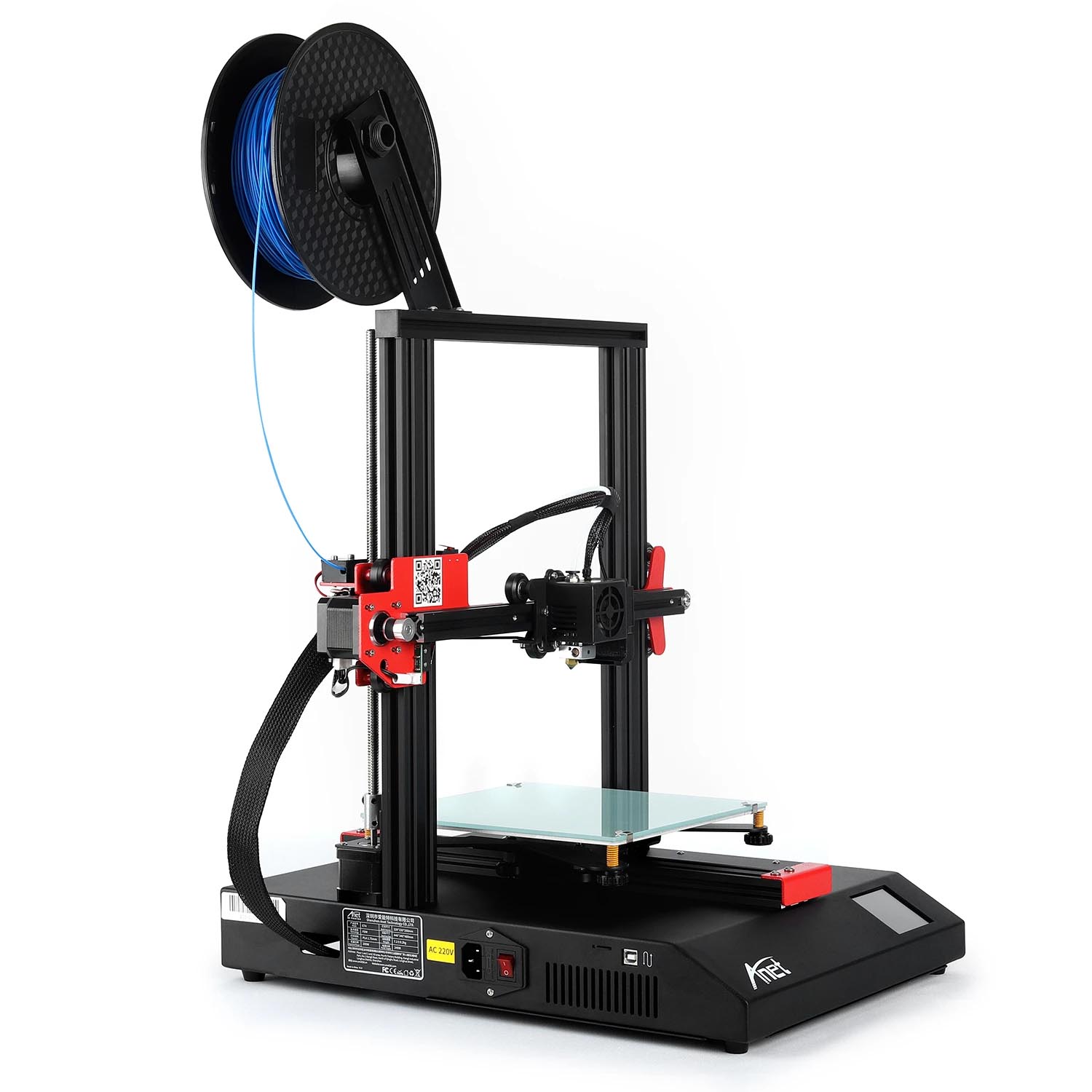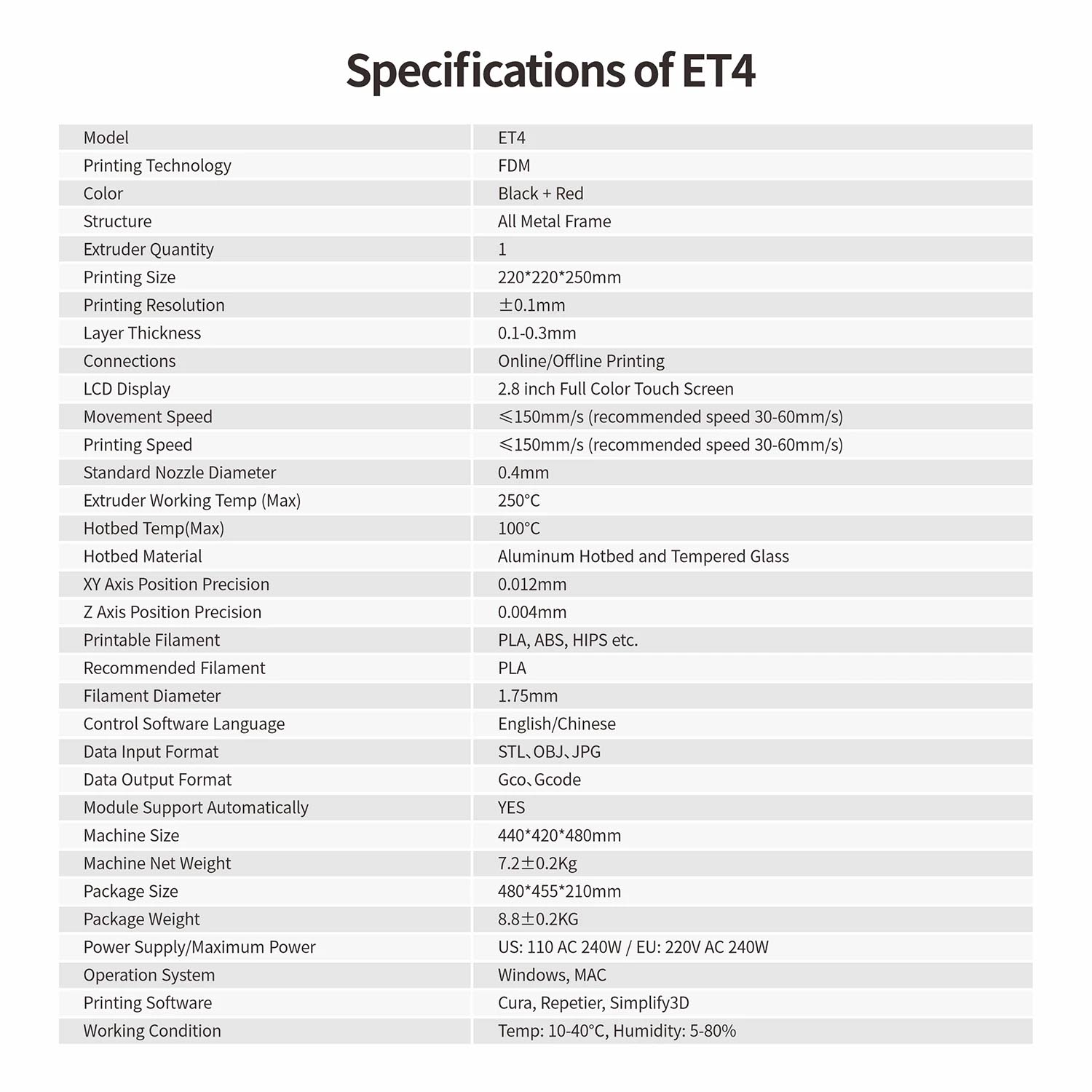The Chinese 3D printers manufacturer Anet has made a name for itself in the world of 3D printing over the past few years with the Anet A8. Its low price and competitive printing quality made it very attractive for many people and it became very popular in a short time. But sometimes cheap can be expensive in the long run, and the dream of the Anet A8 became a bit of a nightmare when some users reported that their 3D printers started catching fire. But that is in the past and this year a new and improved A8 plus is on the market and seems that they have invested in security features. I also think that it is time to give another chance to Anet now that a new promising printer is on the market, the Anet ET4. As they say it is “Designed with safety in mind. The embedded thermistor and heater on the extruder are specially fixed.”
What do I want from a 3D printer? I am a designer, what is important for me primarily is the print quality, consistency and that the printer is easy to use. I don’t want to know much about how 3D printers work, software hacks and workarounds. I want a reliable machine, that has good print quality and doesn’t give me too much trouble.

The Anet ET4 and its specifications. Picture courtesy of Anet.
The ET4 is a DIY desktop 3D printer, once you get it home you have to assemble it. Because of its modular design, it doesn’t take a lot of work to start printing. When you open the box for the first time the assembly is mostly intuitive. It doesn’t have many parts, most of them are built into 3 separate blocks that you can assemble together with a few screws. I just had to check the instructions a couple of times. Unboxing, set up and getting to your first print is very simple overall.
I like the fact that this printer is built on a full-metal frame. It is an aluminum frame that makes it easy to move around since it is not too heavy. It gives a sense of durability and has a compact design that makes the printer quite steady and resistant to vibrations. Although as we have mentioned before the Anet A8 made us feel a bit uneasy when we left a printer home alone working, the ET4 seems quite solid.
Once you turn it on you can control some of the printing features through a 2.8 inch touchscreen that is placed in the base of the printer. I do not like to have my computer connected to the printer all the times so for me the use of the screen on the printer is a must, it makes the work much easier to control. It also lets me check what the settings of the printer such as nozzle and print bed temperature, files to be printed and how long it will take etc. The controls and software were easy enough to use and clear. The UI on the machine was clear enough as well.
One other feature that I find quite handy is the “Resume Printing”: in case the printing is interrupted suddenly the resume printing feature lets you continue the print from where it stops. It comes in quite handy in case of a power outage or some similar issue. But it is not as simple as it sounds, it is true that you can continue the print job but when the machine goes off, the filament, still warm, keeps coming out of the nozzle onto the piece. So this must be scraped away. 3D printing is still a mix of the future and an artisanal craft. In this case, I had to use a very sharp knife to take off that little knot of plastic. Filament end detection on the printer works as advertised.
One of the features that didn’t satisfy me is the auto-leveling. It is quite common in FDM 3D printers nowadays but the ET4 didn’t quite nail down this feature. It has 25 checking points along the print bed, which makes it seem quite promising. For the first print, I did manual leveling, and from then on, I tried to use only the auto-leveling but it didn’t always work properly. In the end, what worked for me was to do manual leveling and then on top of that some auto-leveling. The manual leveling itself is easy to do and works reliably. The retraction settings in the software were reversed but I told the company and this should be fixed soon. I was surprised that no one caught this issue earlier. Loading and unloading new filament, feeding it all went off without a hitch.
Another important aspect for me is the noise level that the printer makes. The Anet ET4 is quite silent, it doesn’t bother me at all to have it in the background printing while I am doing some other work, and I am quite picky about noise. The ET4 has the option of choosing between two stepper drivers, the A4988 and the TMC2208, I got the second one which makes the printer almost silent. You can get the latest updated driver is through their official website. I would definitely recommend spending $15 more for the TMC2208 version of the ET4 if you buy this printer. The quieter drivers make the printer much easier to live with.
And now my favorite part, the print quality. It is the most important aspect for me and I was positively surprised by the results. I use 3D printing to make molds for ceramics but also to 3D print final pieces so I need the results to look professional. With the right print settings, you can get neat results. The printing resolution really delivers, especially for a printer at this price point. I was also very happy with the printing of textures, I have had troubles before with other printers. Sometimes textures can look a bit clumsy or the machine starts making strange noises when making short and fast movements to print small textures. This wasn’t the case here. I was able to, quietly, obtain very high detailed textures for both small and larger parts using this machine. Yes, the printer isn’t perfect but its a good machine for the price.
After over 100 hours printing with the ET4, I am confident in saying that if you are thinking to buy a printer and your budget goes from $200-300 you might want to consider getting one of these. The ET4 is a good choice for a low-cost desktop 3D printer.
3DPrint.com was not paid for this review and I received no money from this review from Anet. Anet did provide me with a review copy of the printer to keep. Other sites charge thousands of dollars for 3D printer “reviews.” We do not do this. We also do not receive money from affiliate marketing from this article. You may disagree with my findings but these findings and opinions are made honestly and with a sincere wish to help you buy a printer, not with an ulterior motive.
Subscribe to Our Email Newsletter
Stay up-to-date on all the latest news from the 3D printing industry and receive information and offers from third party vendors.
You May Also Like
Precision at the Microscale: UK Researchers Advance Medical Devices with BMF’s 3D Printing Tech
University of Nottingham researchers are using Boston Micro Fabrication‘s (BMF) 3D printing technology to develop medical devices that improve compatibility with human tissue. Funded by a UK grant, this project...
3D Printing Webinar and Event Roundup: April 21, 2024
It’s another busy week of webinars and events, starting with Hannover Messe in Germany and continuing with Metalcasting Congress, Chinaplas, TechBlick’s Innovation Festival, and more. Stratasys continues its advanced training...
3D Printing Webinar and Event Roundup: March 17, 2024
It’s another busy week of webinars and events, including SALMED 2024 and AM Forum in Berlin. Stratasys continues its in-person training and is offering two webinars, ASTM is holding a...
3D Printed Micro Antenna is 15% Smaller and 6X Lighter
Horizon Microtechnologies has achieved success in creating a high-frequency D-Band horn antenna through micro 3D printing. However, this achievement did not rely solely on 3D printing; it involved a combination...

































